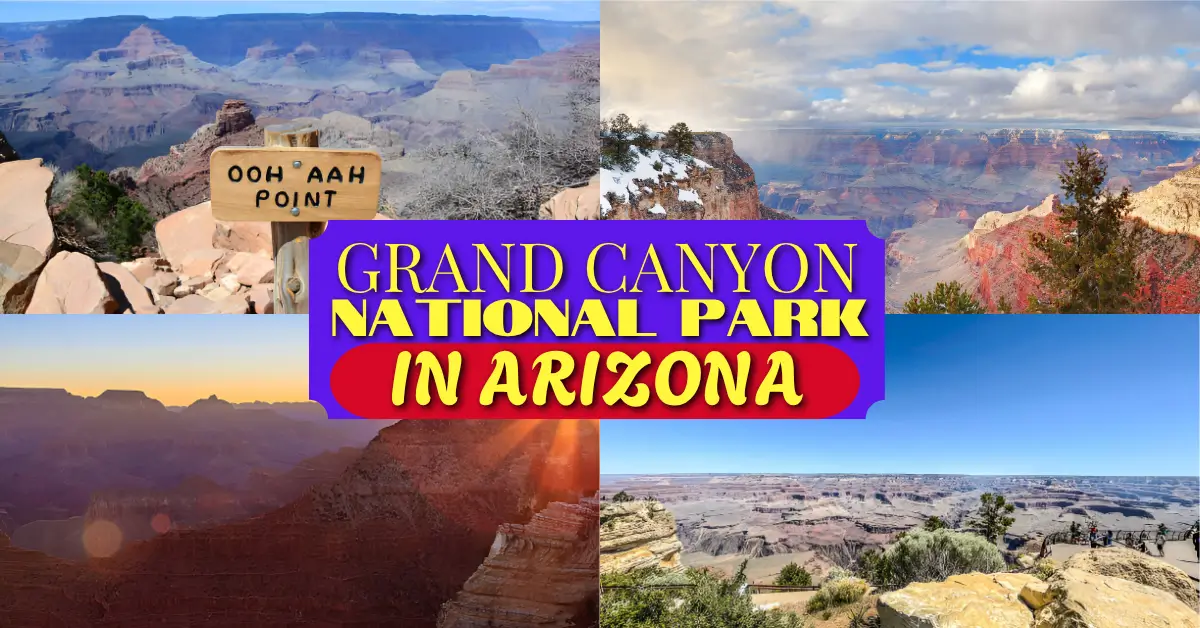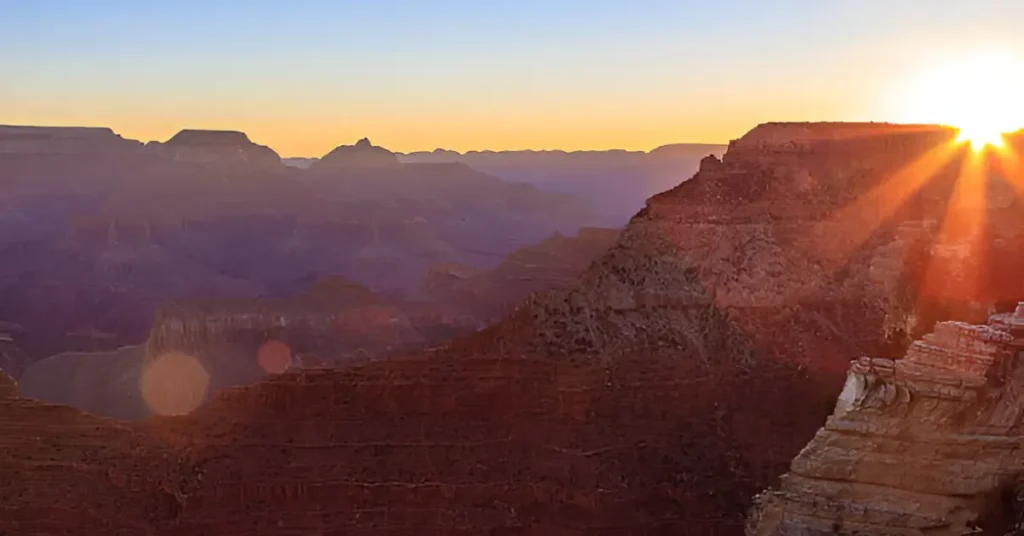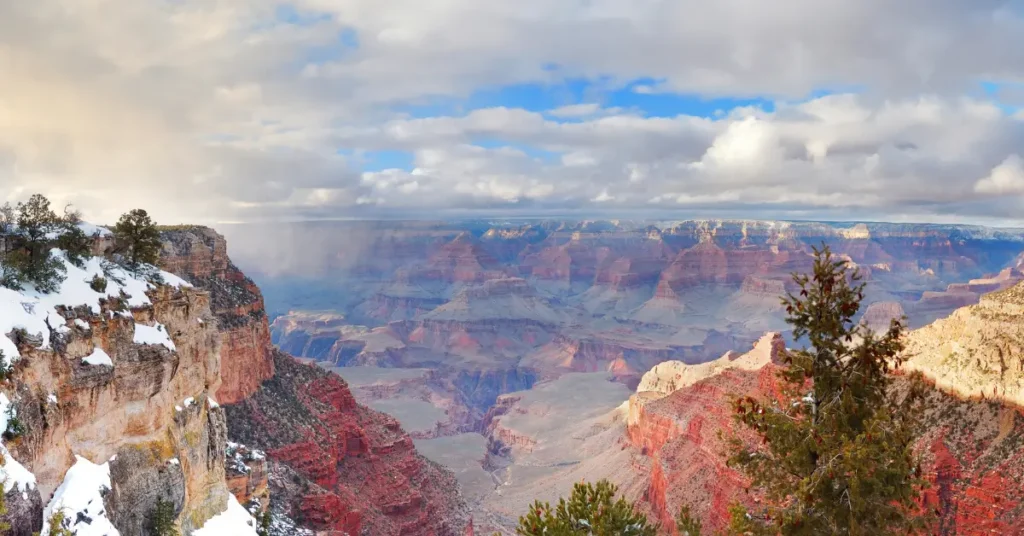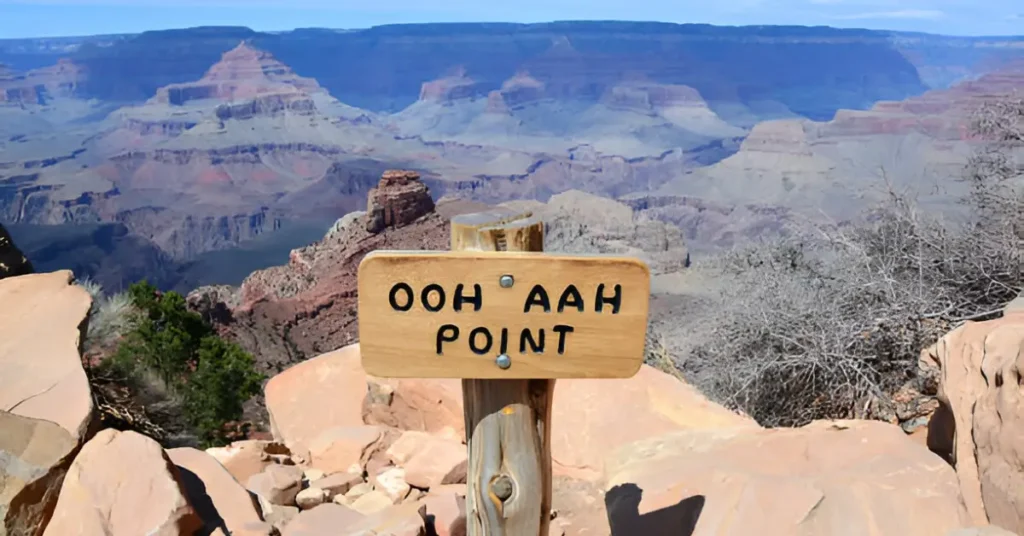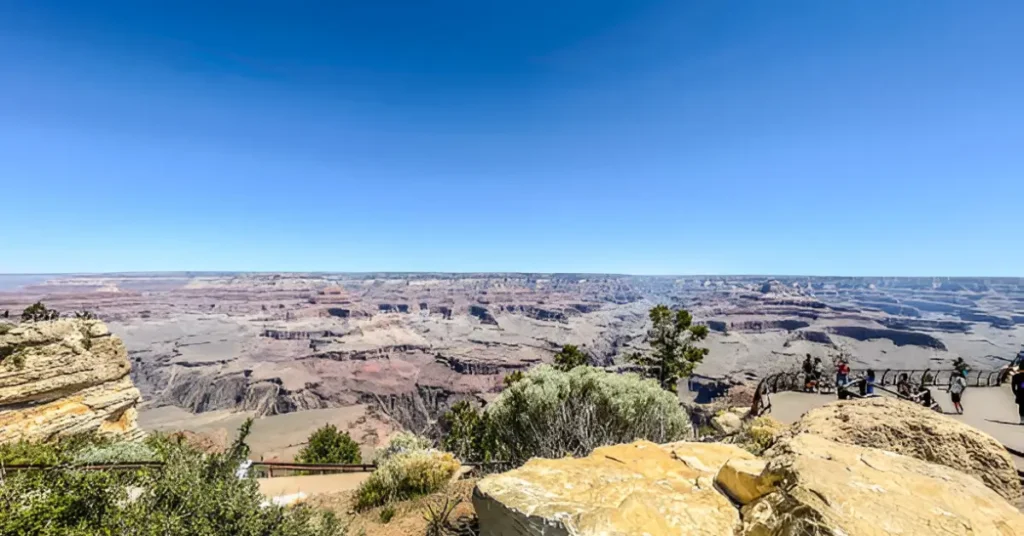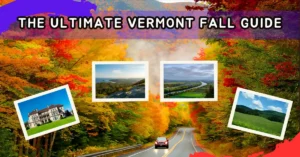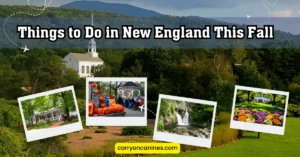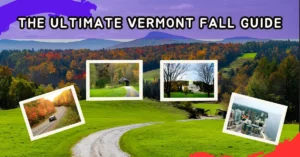The first time I laid eyes on the Grand Canyon, I remember feeling absolutely dwarfed by its scale. Towering cliffs, layered bands of red rock, and the ever-present roar of the Colorado River deep below—it was overwhelming, but in the most beautiful way. This natural wonder isn’t just a landmark; it’s a living storybook carved over millions of years.
If you’re planning a one-day visit to the Grand Canyon National Park in Arizona, trust me—you can absolutely make it memorable without feeling rushed. I’ve done it myself and walked away with lifelong memories, stunning photos, and sore but happy feet. Below is a guide based on firsthand experience, designed to help you get the most out of your day trip.
What Makes the Grand Canyon So Special?
Let’s break down a few terms you might encounter while planning your visit.
Definition List
- South Rim
The most popular and accessible section of the Grand Canyon, open year-round and ideal for first-timers. - Rim Trail
A mostly flat and paved hiking trail along the canyon’s edge, dotted with scenic overlooks. - Shuttle Bus System
Free park-operated transportation that helps reduce traffic and takes you to major trailheads and viewpoints. - Geological Layers
The visible rock strata inside the canyon, each telling a story from a different era in Earth’s history.
When to Visit for the Best Experience
While the park is open year-round, certain seasons offer a more comfortable experience.
Best Time to Visit
| Season | Weather | Crowd Level | Pros | Cons |
|---|---|---|---|---|
| Spring (Mar-May) | Mild, crisp | Moderate | Wildflowers, cooler temps | Can be windy |
| Summer (Jun-Aug) | Hot, dry | High | Long daylight hours | Very crowded, limited shade |
| Fall (Sep-Nov) | Cool, dry | Moderate | Fewer tourists, golden lighting | Shorter days |
| Winter (Dec-Feb) | Cold, possible snow | Low | Peaceful, snowy vistas | Some trails may be closed |
If you’re only coming for a day, try visiting in the shoulder seasons (April-May or September-October). You’ll beat the extreme heat and dodge the peak tourist season.
Start Your Day Early with the Sunrise at Mather Point
I arrived at Mather Point just before 6 AM, coffee in hand, camera ready. As the sun slowly climbed over the horizon, it lit up the canyon walls in fiery golds and deep reds—like watching a slow-moving painting come to life.
● Mather Point is only a short walk from the Visitor Center.
● Arrive at least 30 minutes before sunrise to claim a good viewing spot.
● Bring a light jacket—even in warmer months, mornings can be chilly.
This is the perfect way to begin your Grand Canyon adventure. It grounds you, quite literally, in the awe of nature.
Stop at the Grand Canyon Visitor Center
This isn’t just a tourist formality—it’s your command center for the day. I spent about 30 minutes here picking up a paper map, checking shuttle schedules, and getting insider tips from the rangers (they even helped me adjust my plan to avoid the crowds).
● Located at the South Rim, this is the first major stop after entering the park.
● Includes restrooms, souvenir shops, informative exhibits, and ranger-led programs.
● Start your hike or shuttle ride from here—it’s a major hub.
You’ll also find educational displays about the canyon’s formation and wildlife. A quick walk out back leads to stunning panoramic views as well.
Hike or Stroll Along the Rim Trail
One of the best things about the Rim Trail is its flexibility. Whether you’re an experienced hiker or just want to take a peaceful stroll, this trail delivers.
Trail Snapshot
| Section | Distance (mi) | Est. Time | Features | Accessibility |
|---|---|---|---|---|
| Mather Point to Yavapai Point | 0.7 | 30 min | Easy, paved, great intro to the canyon | Wheelchair-friendly |
| Yavapai to Hopi Point | 3.2 | 1.5 hrs | Stunning viewpoints | Partially paved |
| Hopi Point to Hermit’s Rest | 7.0 | 3+ hrs | Remote, photogenic spots | Not paved |
● I recommend the Mather to Hopi stretch for day trippers.
● You can hop on/off shuttle buses at most major viewpoints.
● Bring water, wear a hat, and use sunscreen—even in spring.
Don’t Miss Yavapai Point and Geology Museum
Yavapai Point remains one of my all-time favorite stops. I remember standing at the edge, mesmerized by the Colorado River far below and trying to mentally trace its winding route. The views are excellent any time of day, but especially late morning when shadows define the canyon’s depth.
Next door, the Yavapai Geology Museum helped me understand what I was looking at—layered rock bands formed over nearly two billion years.
● Indoor exhibits are simple yet eye-opening, great for both adults and kids.
● Viewfinders at the edge help you zoom into specific formations.
● Quiet, often less crowded than Mather or Hopi Points.
Ride Along Hermit Road for the Iconic Viewpoints
One of the most breathtaking parts of my one-day trip was riding the free shuttle along Hermit Road. This 7-mile scenic route hugs the South Rim and includes stops at several legendary overlooks. Since private vehicles are restricted here most of the year, the shuttle makes exploring this stretch stress-free and seamless.
Must-See Stops on Hermit Road
● Hopi Point – Arguably the best place for sunrise and sunset. Sweeping views, dramatic drops.
● Mohave Point – Known for deep canyon views and glimpses of the Colorado River.
● The Abyss – Vertical cliffs that’ll make your heart skip.
● Powell Point – Has a small monument and incredible sightlines across the plateau.
● Hermit’s Rest – Historic stone building with snacks, water, restrooms, and a cozy vibe.
Each shuttle stop is well-marked, and you can get on and off as often as you’d like. I packed a snack and hopped off at three stops, taking my time to enjoy and photograph the views.
Pro tip: Bring binoculars or a zoom lens to spot rafters on the river below.
South Kaibab Trail to Ooh Aah Point – A Quick But Unforgettable Hike
If you’re looking for one hike to give you a taste of the Grand Canyon’s raw beauty, this is it. The South Kaibab Trail to Ooh Aah Point is a short out-and-back route that punches way above its weight in terms of scenery.
I reached the trailhead via the shuttle bus and began my descent just after 9 AM. The path drops quickly through switchbacks and loose gravel, so good shoes are a must.
Trail Details
| Trail Segment | Distance (mi) | Elevation Loss | Duration | Difficulty | Notes |
|---|---|---|---|---|---|
| To Ooh Aah Point | 0.9 (one way) | 686 ft | 1-1.5 hrs | Moderate | No shade or water; go early |
| To Cedar Ridge | 1.5 (one way) | 1120 ft | 2-3 hrs | Moderate-Hard | Worth it if you have the time |
● Ooh Aah Point is true to its name—the layered views literally made me say “wow.”
● Great photo op, especially if you want that mid-trail canyon shot.
● No bathrooms or water—plan accordingly.
Best to start early to beat the sun and the crowds. The trail gets steep on the way back, so take breaks if needed.
Explore Historic Verkamp’s Visitor Center
This was a delightful surprise for me. Tucked right near Grand Canyon Village, Verkamp’s Visitor Center isn’t as well known, but it’s loaded with charm and history. Housed in a former 1906 curio shop, it showcases the early tourism boom and indigenous history of the region.
Inside, I found:
● Historical photos and artifacts from the canyon’s early visitors
● Exhibits about the role of Native American tribes in the area’s culture
● A friendly ranger who shared little-known facts about 20th-century life at the rim
If you’re a history buff or just want a break from hiking, this is a peaceful and educational detour.
Take in the Views from Yaki Point
I wrapped up my afternoon at Yaki Point, a spot I almost skipped—but I’m so glad I didn’t. Accessible only via shuttle or by walking, this overlook has fewer crowds and delivers stunning views of the canyon’s inner gorge.
● Dramatic angles of the South Kaibab trail switchbacks
● Excellent lighting for photos in the late afternoon
● One of the quietest viewpoints on the South Rim
I found a bench, watched the shadows stretch across the canyon walls, and just took it all in. No photos, no phones—just the breeze and the silence.
What to Pack for Your Grand Canyon Day Trip
Don’t overpack, but don’t underestimate the weather either. Here’s what I brought in my daypack—and what I’d recommend to anyone visiting the Grand Canyon for a day.
Essential Packing List
● ● Reusable water bottle (at least 2 liters)
● ● Wide-brimmed hat + sunscreen
● ● Light jacket (even in summer)
● ● Trail snacks (nuts, fruit, energy bars)
● ● Park map + shuttle schedule
● ● Camera or smartphone with extra battery
● ● Sunglasses and lip balm
● ● Hiking boots or grippy walking shoes
● ● First-aid kit (blisters are common)
Optional but helpful: a hiking pole for steep trails, and binoculars for bird or river spotting.
One-Day Grand Canyon Itinerary at a Glance
To help you visualize how a well-paced day at the Grand Canyon can unfold, here’s a sample schedule based on my personal experience.
Sample Itinerary
| Time | Activity | Notes |
|---|---|---|
| 5:30 AM | Arrive at Mather Point for sunrise | Beat the crowds, bring coffee and a jacket |
| 7:00 AM | Breakfast/snack + Explore Visitor Center | Pick up maps, check shuttle times |
| 8:00 AM | Hike short Rim Trail segment (Mather to Yavapai) | Easy, flat, scenic |
| 9:00 AM | Visit Yavapai Point + Geology Museum | Great for photos and geology insights |
| 10:00 AM | Shuttle Hermit Road – Hopi & Mohave Points | Jump off for viewpoints, take your time |
| 12:30 PM | Lunch at Hermit’s Rest | Café and rest area available |
| 2:00 PM | Hike South Kaibab Trail to Ooh Aah Point | Manageable half-day hike |
| 4:30 PM | Relax at Yaki Point | Ideal for late-afternoon serenity |
| 6:00 PM | Depart South Rim | Head back with unforgettable memories |
Common FAQs About Grand Canyon National Park in Arizona
Let me clear up some of the most frequent questions I’ve heard from fellow travelers.
Is one day enough for the Grand Canyon?
Yes—if you focus on the South Rim and plan ahead. You won’t see everything, but you’ll experience the highlights.
Can I drive inside the park?
Private vehicles are allowed on some roads but not on Hermit Road during peak seasons. The shuttle system is reliable and free.
Are there restaurants or food options?
Yes, you’ll find cafés, snack bars, and restaurants at the Village, Hermit’s Rest, and some lodges. But it’s smart to bring your own snacks for flexibility.
Do I need a reservation or park pass?
You’ll need a National Park entrance pass. No reservation is required for general entry, but some tours or lodges do require booking in advance.
Is the Grand Canyon safe for kids and seniors?
Absolutely! Stick to paved trails, avoid steep descents, and use shuttle transport where possible. There are plenty of accessible viewpoints.
Insider Tips for a Stress-Free Trip
From one traveler to another, here are a few things I wish I had known the first time I went.
● ● Arrive early to beat traffic at the entrance gate
● ● Download shuttle maps and hiking guides offline—signal is spotty
● ● If visiting in summer, avoid midday heat by doing indoor activities around noon
● ● Stay hydrated even if it’s cool—the dry air can sneak up on you
● ● Don’t try to “see it all”—slow down and enjoy the moment
My Final Thoughts on the Grand Canyon
Whether you’re standing silently at Yavapai Point or grinning through switchbacks on South Kaibab, the Grand Canyon never stops humbling you. In just one day, you can feel the stillness of deep time, the thrill of nature’s extremes, and a renewed sense of wonder.
The park isn’t just about panoramic views—it’s about perspective. It reminds us how small we are and how big our world really is.
If you’ve got just 24 hours to explore Grand Canyon National Park in Arizona, don’t hesitate. You’ll leave with dust on your shoes, sunlight on your face, and something unforgettable lodged deep in your memory.

